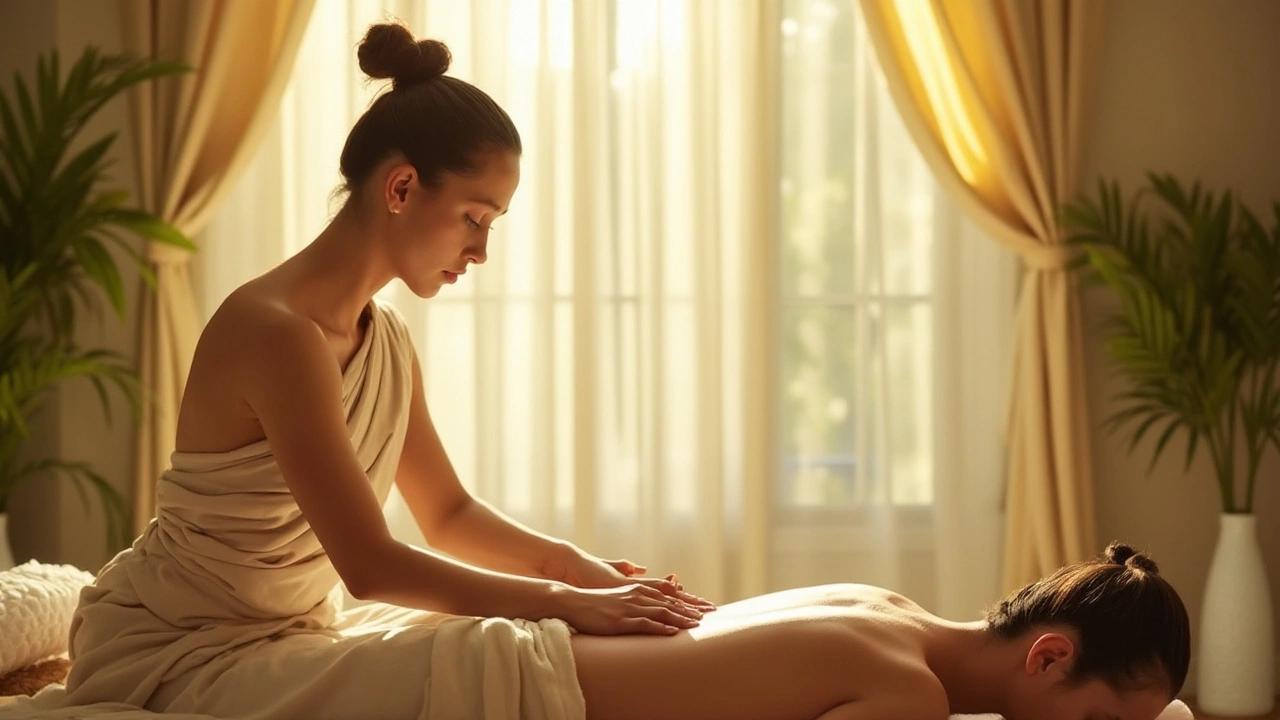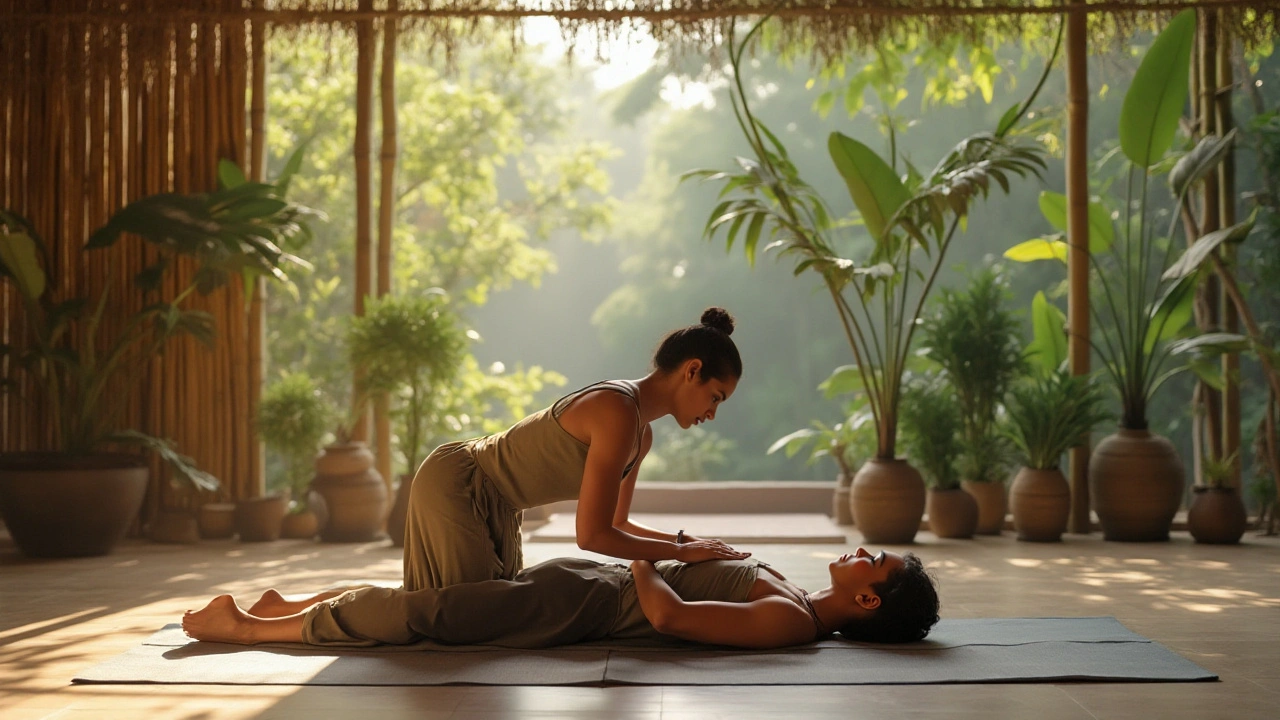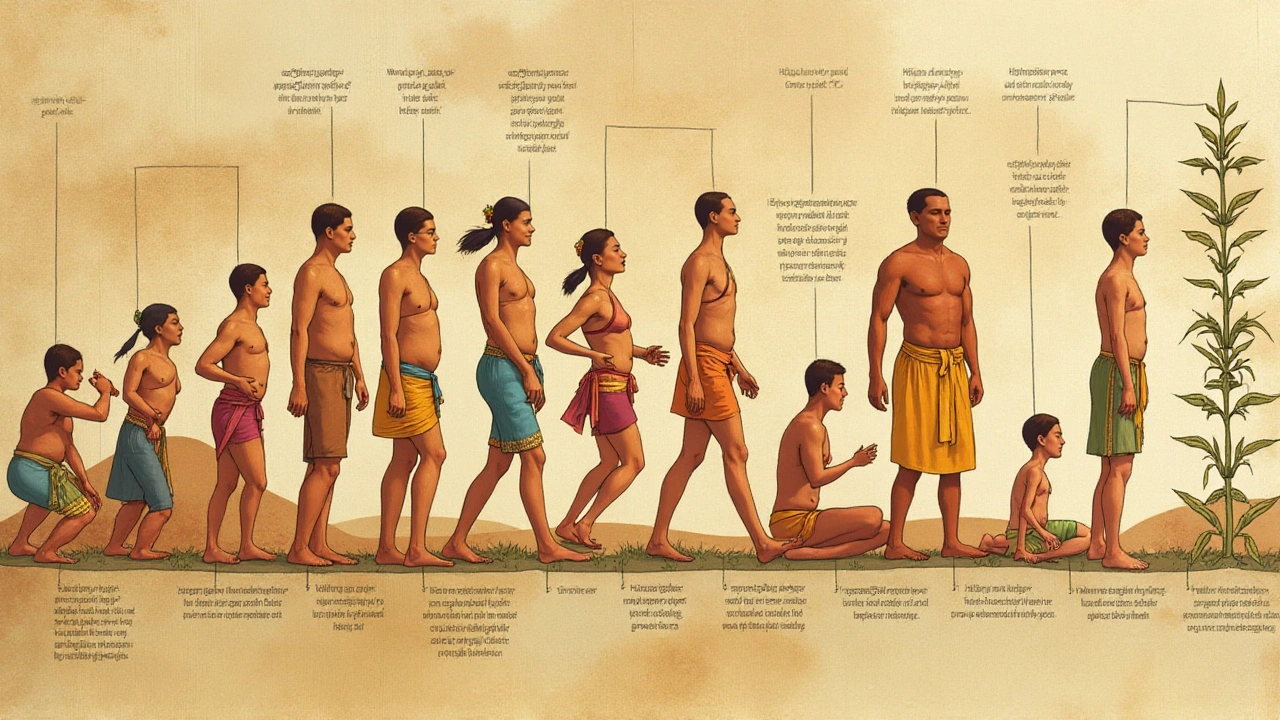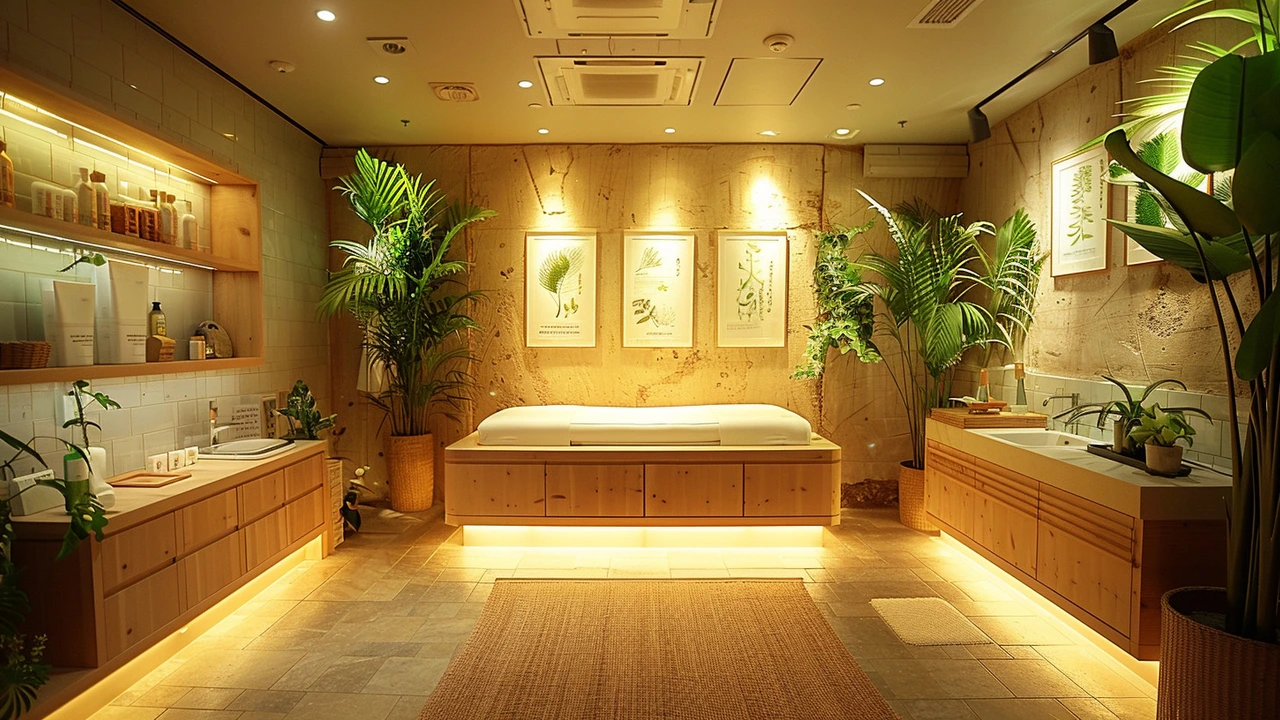Unlocking the Therapeutic Secrets of Thai Bodywork

In the fast-paced tapestry of today's world, where stress tends to overshadow well-being, ancient healing practices often emerge as beacons of balance. Among these, Thai bodywork stands out as a unique blend of therapeutic techniques that promise not just physical relief but soul-deep rejuvenation.
Emerging from the tropical heart of Thailand, this practice reflects centuries of traditional wisdom. It's a dance of energy and touch, often likened to assisted yoga, with a focus on nurturing the body's natural healing processes. Those who have discovered its touch speak of transformations—muscles untangling knots of tension, minds shedding layers of stress.
Yet, what makes Thai bodywork truly captivating is how it intersects with modern understanding of anatomy and health. It doesn't just rest on history but evolves, adapting to offer tangible healing benefits. Ready to dive into this world, to explore the nuances and learn why this practice remains cherished by many?
- The Origins of Thai Bodywork
- The Science Behind Thai Massage
- Physical and Mental Health Benefits
- Understanding Common Techniques
- Integrating Thai Bodywork into Your Routine
- Choosing the Right Practitioner
The Origins of Thai Bodywork
The story of Thai bodywork is a rich tapestry woven from several cultural traditions, dating back over 2,500 years. This ancient practice originated in Thailand but was heavily influenced by the healing systems of India and China, making it a testament to cross-cultural exchange. The mythical founder of Thai massage is said to be Jivaka Kumar Bhaccha, a contemporary of the Buddha and a medical doctor from northern India. His influence came through the introduction of Ayurvedic principles, which are fundamental to many of the techniques used in Thai massage today.
In Thailand, this bodywork evolved in tandem with the country's spiritual growth, largely within Buddhist monasteries. Monastics often sought balance and harmony in their health rituals, which naturally complemented their meditative practices. This coalescence of techniques was preserved in wat (temples), which served as both spiritual and healing centers. One of the most famous is Wat Pho in Bangkok, where the practice continues to be taught and revered. It's fascinating how the integration of these principles over centuries led to a therapy that marries physical healing with mental clarity.
The foundation of Thai bodywork rests on the belief in invisible energy lines or ‘Sen’ that run through the body. Think of Sen as superhighways carrying vital energies necessary for bodily functions and mental well-being. Blockage or imbalance in these lines often manifests as discomfort or illness. This understanding is beautifully encapsulated in Thai therapeutic methods, which offer precise pressure applications, rhythmic compressions, and stretches to release these blockages. A rare blend of effort and ease, Thai bodywork is therapeutic not just for the receiver but for the practitioner as well, fostering a unique healing dance.
"Thai massage is not just a physical practice; it's a spiritual dance," says Kam Thye Chow, founder of the renowned Lotus Palm School. His words echo the sentiments of many who have experienced the healing art's profound effects.
Universally practiced throughout Thailand, the technique has seen numerous adaptations as it spread beyond its borders. This diffusion allowed the practice to incorporate elements from different cultures, further enriching its repertoire. The preservation of ancient Thai scriptures, better known as the Thai Traditional Medical Scripts, still informs modern Thai bodywork practices. These texts are sacred and cherished, inscribed with traditional healing methods reflecting a deep respect for the human body's natural rhythms and energy flows.
Thai massage is more than the sum of its practices; it's a living reflection of Thai culture. The devotion to mindfulness, balance, and connectivity reflects the nation's spiritual ethos. Today, enthusiasts and practitioners across the globe continue to explore and embrace Thai bodywork, not only as a wellness ritual but as an art form that pays homage to a profound historical legacy. The resurgence in its popularity speaks to our contemporary quest for holistic health solutions and a renewed appreciation for ancient wisdom. As one delves into its origins, the story of Thai bodywork unfolds as a dialogue between the past and the present, a journey that invites participation from all who seek deeper healing.
The Science Behind Thai Massage
When you delve into the world of Thai massage, often referred to as "lazy person's yoga," it becomes clear there's more to it than meets the eye. This ancient practice, rooted deeply in Southeast Asian traditions, blends physical and energetic health, grounded in acupressure, stretching, and reflexology. Its methods are designed not merely to ease muscular tension but to foster a profound internal harmony. Western science increasingly supports these claims, providing insights into the mechanisms underlying this traditional practice.
The bodywork technique focuses on energy lines known as "Sen" which bear semblance to the Ayurvedic nadis or the meridian lines in Traditional Chinese Medicine. By stimulating these pathways, Thai massage is believed to balance the body's energy flow, enhancing vitality and reducing blockages that often result in physical discomfort. Research indicates that manipulating muscles and joints can facilitate the release of "feel-good" neurotransmitters, such as serotonin and dopamine, effectively alleviating stress and anxiety.
Recent scientific studies have shed light on Thai massage's ability to improve circulation and flexibility, crucial for maintaining joint health and function. It has been documented in research from the Journal of Alternative and Complementary Medicine that a single session can significantly enhance peripheral blood circulation, making it a valuable therapy for those with ailments that impair blood flow. Notably, a clinical trial revealed a 3% increase in arterial circulation following a session, highlighting its potential benefits for cardiovascular health.
Dr. Jian Kong from Harvard Medical School notes, "While once considered a fringe therapy, the effects of Thai massage on enhancing physical performance are undeniable. It connects traditional practice with modern physiology in ways we are only beginning to understand." Such testimonials underscore the practice's scientific backing, linking it to tangible health improvements that extend beyond mere relaxation. Participants often report therapeutic gains not just in terms of physical release but greater emotional and psychological resilience.
It is important to note that typical sessions last from 60 to 90 minutes, during which practitioners apply rhythmic pressure from head to toe, often using feet, elbows, or forearms to deliver precise, calibrated force. According to Thai bodywork experts, this mimics the motion of yoga, increasing limberness and balance. Regular sessions can lead to substantial improvements in range of motion, an advantage supported by studies highlighting a 10% augmentation in flexibility among regular recipients over a two-month period.
The science behind Thai massage continues to evolve, with ongoing studies that delve deeper into its potential as a complementary therapy. As researchers work to unlock the mysteries of how these techniques impact our physiology, the allure of Thai bodywork persists, inviting those who seek a natural path to wellness to explore its enriching realms.

Physical and Mental Health Benefits
Engaging in Thai massage offers a rich tapestry of physical and mental health improvements. At its core, this traditional bodywork is designed to invigorate the body's physical realm, promoting flexibility and enhancing muscle tone. By utilizing precise acupressure points along the body’s energy lines or 'Sen', practitioners help to release blocked energy channels, leading to a feeling of revitalization and comfort. A physically demanding session might involve the rhythmic application of pressure using palms, thumbs, elbows, and feet, which helps increase circulation and oxygenates vital organs.
Beyond its physical implications, Thai bodywork has profound mental benefits. Regular sessions can significantly reduce anxiety, muddled by the fast-paced demands of contemporary life. Many participants report a serene state of mental clarity long after their sessions. This tranquility often arises from the meditative nature of the practice, which encourages patience and deep breathing—essential allies in stress management.
The World Health Organization has recognized therapeutic massage, such as Thai bodywork, for its role in preventing and managing stress-related conditions. This recognition underscores its mental health credentials. A study published in the Journal of Alternative and Complementary Medicine noted that participants saw a marked improvement in their overall mood and reported fewer symptoms of depression after regular Thai massage sessions.
"The intricate art of Thai massage not only alleviates physical discomfort but also elevates the spirit, leading individuals towards a harmonious state of being," highlighted Dr. Kanya King from the International Thai Traditional Medicine Council.
One of the surprising benefits that many enthusiasts experience is improved sleep quality. The relaxation of muscles and the alignment of bodily energy paths contribute to better sleep patterns, which is often elusive for many in today's society. This is precisely why integrating Thai massage into a regular wellness routine can provide a holistic health boost. In terms of physical therapy, it can be a guiding light for those suffering from chronic pain. By easing tension in concentrated areas, it contributes to long-term pain reduction without the need for medication.
For those seeking to blend this practice into their lives, it is advisable to consider a consistent schedule, similar to a workout routine. As the body becomes familiar with the treatment, the benefits can become more pronounced, yielding both immediate relief and long-term well-being. This deep focus on synchronization of body and mind makes Thai bodywork an invaluable practice in promoting balanced health.
Understanding Common Techniques
Diving into the world of Thai massage approaches requires not just an open mind but a willingness to embrace an entirely different rhythm of wellness. At its heart, Thai bodywork involves a unique blend of yoga-like stretching with deep-tissue massage and acupressure. This synergy aims to free the flow of energy throughout the body, closely aligning with Ayurvedic beliefs and practices. Practitioners often use their thumbs, palms, elbows, knees, and feet to execute these movements, creating deep pressure and enjoyable stretches all over the body.
One of the most fascinating aspects of these methods is their focus on the 'sen' lines. These energy pathways, akin to the meridian lines in Chinese medicine, are thought to channel the body's vital force. By applying pressure strategically along these lines, practitioners are said to unblock energy stagnation, promoting a sense of physical and spiritual relaxation. A simple but effective technique often incorporated is known as 'thumb walking', which involves methodical pressure applied along the sen lines with the practitioner's thumbs.
Rhythmic Compression and Rocking
Another important technique is rhythmic compression and rocking, which aids in calming the nervous system and loosening muscle knots. This method often draws comparisons with the lulling sensation of being gently rocked to sleep. By instilling a comforting repetitive motion, clients are eased into a state of deep relaxation, enabling them to fully absorb the benefits of the therapy. Acknowledged by experts for its therapeutic value, this technique often addresses stress-induced muscle tightness effectively.
As Dr. Ananda Apfelbaum, an expert in traditional healing practices, affirms, "Thai bodywork is a symphony of movements that bring together elements of stretching, rocking, and pressing, each method with its own specific impact on the body's subtle energies."
Assisted Stretching
An equally integral part of Thai bodywork is assisted stretching, where clients are moved into yoga-like postures. This active participation is intended to boost flexibility and open up energy channels. The practitioner gently guides the recipient through various stretches, applying pressure at crucial junctions to enhance the stretch and its effectiveness. It’s much like having a yoga class where you are pampered rather than pushed, and this element of personal touch can make a significant difference to those who are not accustomed to regular stretching exercises.
These techniques intertwine to create a therapeutic dance that connects both the giver and the receiver, often leaving both parties with a sense of mutual benefit and a magnetic therapeutic experience.

Integrating Thai Bodywork into Your Routine
Bringing the ancient art of Thai bodywork into your daily life might seem like an exotic leap, yet it’s surprisingly accessible and immensely rewarding. Understanding and appreciating its profound benefits starts with a commitment to regular practice. Firstly, it’s important to find a routine that suits your lifestyle and health goals. Regular sessions can be weekly or bi-weekly, depending on how your body responds. The key is consistency. Just like any wellness practice, the cumulative effect over time enhances its benefits. Even those new to this kind of therapy have found marked improvements in flexibility and reduction in chronic pain when they maintain regular sessions.
Reflecting the rhythmic dance of energy that it is, incorporating Thai bodywork might also involve learning some basic techniques for self-care. Gentle stretches or simple acupressure methods can be practiced at home, offering a bridge between professional sessions. By understanding these techniques, you harmonize the flow of energy and extend the therapeutic touch beyond the session itself. This is where the disciplined practice akin to yoga comes into play. It's about creating a daily space where you mindfully engage with your body, whether through solitary stretches or in unison with a trained professional.
Many people find solace in the systematic approach of Thai bodywork, which naturally complements practices like yoga and Pilates. The beauty of these combinations lies in the mutual enhancement of body awareness and flexibility. Some athletes have noted that integrating these practices into their training regimens leads to improved performance and injury prevention. Imagine a long-distance runner discovering that Thai bodywork not only relaxes tired muscles but also enhances circulation and speeds recovery. The age-old techniques of compressions and stretching prove particularly beneficial in such cases.
"Thai bodywork offers a truly holistic approach to wellness that fosters harmony in both body and mind," says Dr. Samantha Lee, a well-respected wellness practitioner.
Creating a serene environment at home can also make a huge difference in integrating Thai bodywork. This could be as simple as a dedicated space with a mat, incense, and calming music. Imagine this sacred corner being your personal retreat where the day’s stress is kneaded away. Even replicating some of the sensory elements experienced during a professional session can enhance your home practice, creating a deeper connection to the rejuvenating art.
For those interested in a more structured approach, tracking progress through a journal can be enlightening. Recording the shifts in flexibility, mood, or sleep patterns helps in observing subtle changes and keeps motivation high. Whether it's a noticeable relief in shoulder tension or an unexpected boost in energy, these notes become a testament to the healing journey. Some practitioners even encourage clients to note their emotional state pre and post-session, which offers insights into the mental peace that traditional bodywork fosters.
Finally, connecting with a community of enthusiasts can provide both inspiration and support. Workshops and group sessions allow for shared experiences and learning new techniques. Joining a community also opens avenues to explore deeper into the cultural essence of Thai bodywork, offering not just physical benefits but also a richer appreciation of its cultural roots. It’s a reminder that holistic health is not a solitary journey but one shared across borders and traditions.
Choosing the Right Practitioner
Finding the right practitioner for Thai massage can significantly affect your healing journey and overall experience. The expertise and energy of the practitioner often play as vital a role as the techniques employed. To start with, it's essential to research their background. Look for a practitioner who has undergone training under recognized programs. In Thailand, organizations like the Wat Po Thai Traditional Medical School provide reputable courses, offering a strong foundation in the principles and practice of Thai bodywork.
Credentials and Experience Matter
Experience speaks volumes in any therapeutic practice. While training can teach the basics, years of hands-on experience refine a practitioner's touch. A seasoned practitioner will have encountered a variety of body types and conditions, enhancing their intuition and adaptability. Don't hesitate to ask about their years of practice and request testimonials from previous clients. Many professionals build a following based on word-of-mouth recommendations.Trust Your Instincts
Trust your instincts during your initial consultation. Observe how the practitioner engages with you and whether they take the time to understand your specific needs and concerns. A good practitioner will ask questions, seeking to tailor the session to your personal energy profile and health goals. This dialogue is essential in building trust and ensuring you feel comfortable throughout the process.Understanding Different Styles
Thai bodywork isn't a one-size-fits-all practice, and styles can vary between practitioners. Some may focus on traditional methods heavily rooted in pressure points and energy lines, while others might integrate elements of modern wellness practices. Understanding these styles can help you align with a practitioner whose approach resonates with your personal wellness philosophy. "The journey to healing is as personal as the spirit itself," noted renowned spa director Suki Mori, emphasizing the tailored nature of effective bodywork.Consider the Environment
The environment where your healing therapy session occurs also contributes to the overall impact. Seek out practitioners whose spaces offer a serene and inviting atmosphere. Often, the ambiance of the session room, including factors like music, scent, and lighting, can enhance relaxation and the therapeutic benefits of the massage. A well-designed space helps in grounding you, allowing the body to release tension more effectively.Checking Credentials
Lastly, cross-reference their credentials and verify memberships with professional bodies that uphold high standards of practice. Organizations like the Thai Healing Alliance International provide certifications to practitioners meeting their criteria, offering an additional level of assurance. This diligence ensures not only professional integrity but also peace of mind.Ultimately, your choice of a Thai bodywork practitioner should reflect a blend of skill and compatibility. By considering these factors, you enhance your chances of finding someone who can guide you towards holistic health and wellness transformation.





